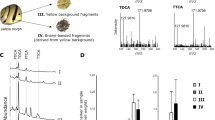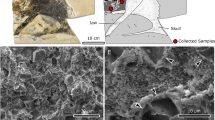Abstract
THE pigmentation of the isopod crustacean Asellus aquaticus is chiefly due to a melanin1 distributed in granular form in the cytoplasm of stellate cells of the usual arthropod-type, underlying and interpenetrating2 the epidermal cells. The newly eclosed regenerating limb is macroscopically unpigmented, and is very conspicuous. Microscopically, incipient pigmentation is sometimes visible, and otherwise becomes evident in a day or two, as golden-brown granules, in the cytoplasm of large wandering cells (17 µ or larger), at the time when these presumptive pigment cells first begin to assume their definitive position, and their asteroid form. These large wandering cells are a conspicuous feature of the newly eclosed limb, and decrease in number as pigmentation progressively develops, during the stadium following eclosion.
This is a preview of subscription content, access via your institution
Access options
Subscribe to this journal
Receive 51 print issues and online access
$199.00 per year
only $3.90 per issue
Buy this article
- Purchase on Springer Link
- Instant access to full article PDF
Prices may be subject to local taxes which are calculated during checkout
Similar content being viewed by others
Author information
Authors and Affiliations
Rights and permissions
About this article
Cite this article
NEEDHAM, A. Formation of Melanin in Regenerating Limbs of a Crustacean. Nature 164, 717–718 (1949). https://doi.org/10.1038/164717b0
Issue Date:
DOI: https://doi.org/10.1038/164717b0
This article is cited by
-
The integumental pigment ofAsellus
Experientia (1957)
Comments
By submitting a comment you agree to abide by our Terms and Community Guidelines. If you find something abusive or that does not comply with our terms or guidelines please flag it as inappropriate.



